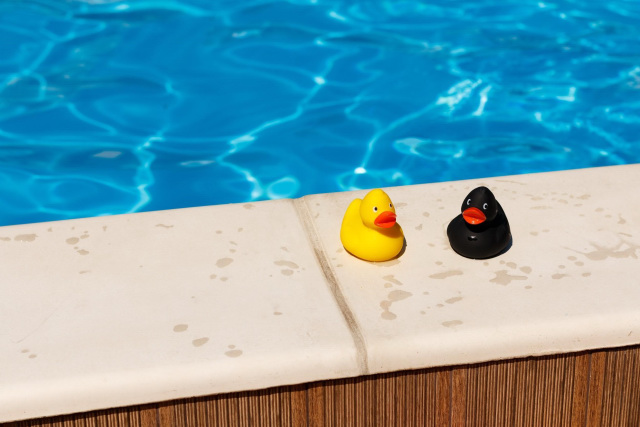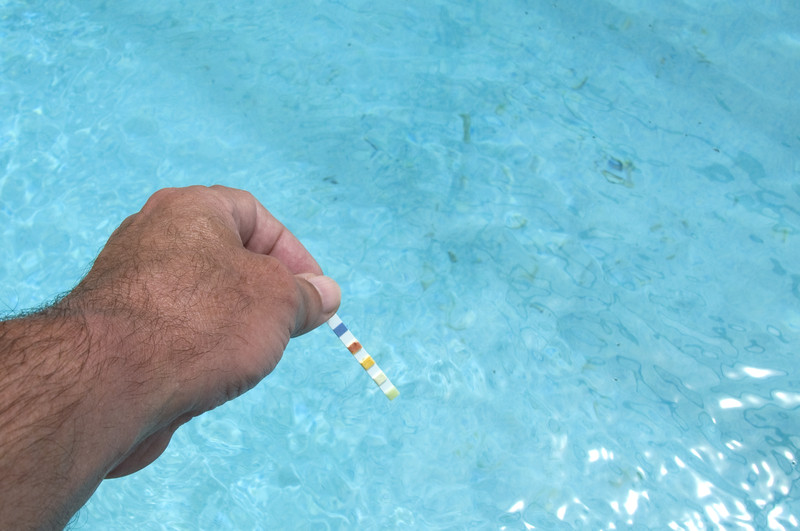If you’ve been wondering how to lower alkalinity in your pool, you are not alone. Many pool owners across the globe have expressed concerns about their pool alkalinity being too high and not having a clue what to do to lower it. Fortunately, high alkalinity is 100% curable so long as you know what to look for.
If you’re in a hurry, the short and sweet answer to lower the alkalinity in your swimming pool is by adding either muriatic acid or sodium bisulfate.
Follow along for the step-by-step approach where we discuss the key product differences, review the safest and most effective application, and answer the top frequently asked questions when it comes to lowering pool alkalinity.

Article Contents
Let’s Talk about Alkalinity
Alkalinity refers to a solution’s capacity to resist acidification. In other words, it’s a measure of how much acid your pool water can dissolve and neutralize.
What Is Alkalinity In A Pool?
It’s important to note that alkalinity is different from basicity. Where basicity is a measurement on the pH scale (greater than 7.0), alkalinity refers to the strength of a solution that contains a weak acid and its related base.
So just to be clear, we’re not talking about pH levels when we’re talking about alkalinity or total alkalinity.
Although different, they work together harmoniously in your swimming pool. Alkalinity acts as a buffer for pH, helping to keep it within a stable range. Without alkalinity, your pool’s pH would rise and fall randomly over time.
What Causes High Alkalinity in Pools?
There are a variety of reasons why your swimming pool has high alkalinity. Some of the most common causes include:
- Adding too much sodium bicarbonate (baking soda) when attempting to raise the pH
- Using too much acidic sanitizer
- Rain build-up
- Filling a pool with well water that is high in calcium
Effects of High Alkalinity in Pool
As mentioned earlier, alkalinity is associated with pH. When alkalinity is too high in your pool, pH will usually be high too. Alkalinity and pH generally rise and fall at the same time. Together, these both contribute to increased levels of calcium.
When alkalinity is high your pool may have these issues:
- Cloudy water
- Chlorine may not be as effective
- Scaling
- Clogged filters
- Swimmers may experience skin or eye irritation
At the end of the day, it’s bad news for everything and everyone to have high alkaline pool water.
What Should Alkalinity Be in A Pool?
As a pool owner, you either know or will find out in time that the pH and alkalinity are two very important features of your pool. Fortunately, you can keep these both in balance when you know what to look for.
The best alkalinity range for a swimming pool is anywhere between 80 and 120 parts per million (ppm). Additionally, the best range in pH is between 7.2 and 7.6.
The bottom line is that when your swimming pool total alkalinity exceeds 120 ppm, you need to begin the process of lowering it.
How to Lower Alkalinity in a Pool – Step by Step
Step1: Select a product
There are a variety of options you can use to lower your pool’s alkalinity. Although slightly different chemistry, they work to achieve the same thing. Let’s take a look at the top 2 products on the market.
Product #1: Muriatic Acid
Muriatic acid is one of the more common choices for balancing your pool’s chemistry. It’s an extremely strong acid used not only to lower total alkalinity but also to help remove any built-up rust or calcium deposits.
Although effective, muriatic acid is stronger than other products and can result in burning of the skin or damage to the pool surfaces if not used with caution.
Product #2: Sodium Bisulfate
Sodium bisulfate, also known as dry acid or acid salt, is another popular choice for many pool owners. It works in the same way as muriatic acid, however, it’s much safer to handle. Keep in mind that it could also be sold under the names ‘pH Down”, “pH Minus”, “Alkalinity Decreaser”or “Alkalinity Down”.
You can find pH Down here.
Step 2: Add the product
After carefully reading over the instructions on the product label, you can begin to add it to your pool. First choose your product; muriatic acid or sodium bisulfate then follow the instructions for your choice below.
Product #1: Muriatic Acid
- Test your pool for total alkalinity. Find out if the levels are high, and by how much.
- Review the product label to determine how much acid to add based on the current alkalinity and the volume of your pool (see table below).
Only add a small amount to the pool at a time and don’t add muriatic acid all at once. - Dilute the acid or add it directly into the pool, depending on the instructions.
- If you need to dilute, it’s usually a 10:1 mixture of water to acid.
- Add the diluted solution to the deep end of the pool.
- Run the pump and circulate the water for a few hours. Wait at least 5 hours before moving onto step #3 (retest the water).
Amount of Muriatic Acid to Lower Alkalinity (and pH)
| Pool Volume (gal) | < 80 ppm Alkalinity | 80-120 ppm Alkalinity | 130 ppm Alkalinity | 140 ppm Alkalinity | 150 ppm Alkalinity | 160 ppm Alkalinity |
| 1,000 | Add Baking Soda | Ideal | 3-5 fl oz | 4-6 fl oz | 4-7 fl oz | 4-7 fl oz |
| 5,000 | Add Baking Soda | Ideal | 17-29 fl oz | 20-32 fl oz | 20-33 fl oz | 21-35 fl oz |
| 10,000 | Add Baking Soda | Ideal | 35-60 fl oz | 37-63 fl oz | 40-67 fl oz | 42-71 fl oz |
| 20,000 | Add Baking Soda | Ideal | 2-3½ quarts | 2-4 quarts | 2½-4 quarts | 2.5-4½ quarts |
| 30,000 | Add Baking Soda | Ideal | 3-5½ quarts | 3½-6 quarts | 3¾-6¼ quarts | 4-6½ quarts |
Product #2: Sodium Bisulfate
- Test your pool for total alkalinity. Find out if the levels are high, and by how much.
- Review the product label to determine how much dry acid to add based on the current alkalinity and the volume of your pool. Most experts recommend adding ¾ of the instructed amount.
- Depending on the product, you may be advised to dilute the sodium bisulfate in water first.
- Pour the powder (or diluted mixture) into the deep end of the pool.
- Run the pump and circulate the water for a few hours. Wait at least 5 hours before moving onto step #3 (retest the water).
Step 3: Test the alkalinity (and pH) of your pool

It’s time to start testing the water! Make sure you have a reliable testing kit for both total alkalinity and pH.
You can use either pool water testing strips or a liquid water testing kit.
Begin to take readings after 6 hours, then 24 hours, then 48 hours to gauge if there are any small changes over this period and to ensure the chemicals are balanced. Make sure that both the total alkalinity and pH values are within optimal ranges. If so, your job is done!
Step 4: Repeat (if necessary)
If your alkalinity and pH values are still too high, continue adding the solution in small increments and testing until your pool is back to normal ranges.
It’s important to note that testing for alkalinity first is far more useful. When the total alkalinity is within 80-120ppm it will help to buffer the pH, resulting in less frequent disruptions in pH.
Related Reading: Using Sodium Bisulfate to Lower pH & Alkalinity in Pool
Pool Alkalinity FAQ
Can you swim in a pool with high alkalinity? Is it safe to swim?
Swimming in a high alkaline pool can present some problems. Alkaline water tends to disrupt the chemical activity of chlorine. As a result, your swimming pool will have microorganisms and other contaminants present that can be harmful to your health.
Does high alkalinity cause cloudy pool water?
Yes, as a result of the increased calcium content created by high alkalinity, the pool water tends to become cloudy. This is an important visual indicator that both your pool’s pH and alkalinity levels are too high.
How to lower alkalinity in a saltwater pool?
Saltwater pools tend to be more prone to scaling because salt itself is more corrosive. Based on this, using muriatic acid in a saltwater pool is helpful to lower the alkalinity and clean up the scaling build up. Just follow the process above on lowering alkalinity.
How to lower alkalinity in an above ground pool?
The major differences between an above ground pool and an in-ground pool is the volume of water it holds and the filtering system used. At the end of the day, either muriatic acid or sodium bisulfate will do well in reducing alkalinity levels in an above ground pool.
Over to You
A swimming pool is a family-friendly sanctuary to create new and exciting memories in. Keeping a safe swimming environment for your friends and family to enjoy is key! That’s why it’s very important to check in on your pool’s alkalinity and pH levels to ensure nothing is out of balance.
We are all human, and sometimes that means even the best of the best pool owners must deal with low alkalinity. Our suggestion is to watch out for any indicators of alkalinity changes by testing your pool weekly and having essential products on standby, just in case!
Take time to consider the differences between both muriatic acid and sodium bisulfate when dealing with low alkalinity in your pool. Let us know what you find out about each product and if you have a favorite!
Recommended Products
Favorite Pool Products
Related Reading:
How to Raise Alkalinity in Hot Tub (Alkalinity is Low)
How to Lower Alkalinity in Pool Without Affecting pH
The Easiest Ways to Remove Calcium Deposits from Pool Tiles


extremely helpful to me! thank you!